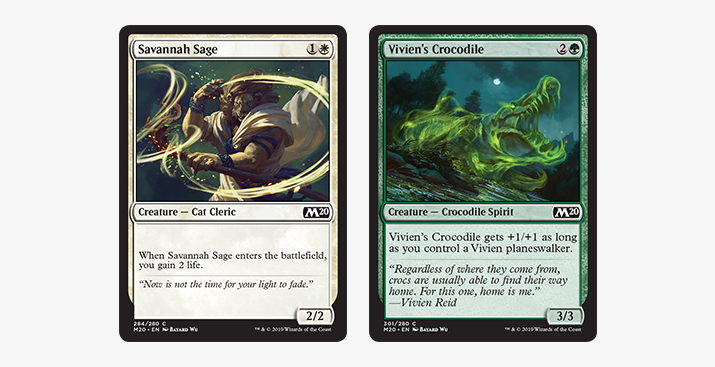Jun 26, 2019
Mark Heggen: R&D's Plan to Make New Magic Players
M19's product suite helped create the most successful new player season ever. So we're doing it again for M20—with a few tweaks.
Hello! I’m Mark Heggen from Magic's design studio, where I oversee our acquisition-focused products. Last year, with Core Set 2019 (M19) we launched a new approach to Core Set Planeswalker Decks, aimed at better approachability, better play, and a better transition between products—all of which we hoped would equip retailers to bring new players on board with the greatest ease possible.
We’ve been thrilled with how all these changes have played out. In the period between M19 and M20, more new players have joined in-store play than any previous year in Magic's history.
We like to think that has something to do with the improvements we've made to new player-focused products, so we’re repeating the approach with M20—but with a few important tweaks.
As a quick recap, the big changes to the Planeswalker Decks were:
- Going from 2 to 5 decks. This way new players can continue their journey with the same color as their Welcome Deck.
- Moving to a more accessible price point. We moved from two booster packs to one to keep the barrier to entry as low as possible.
- Overlap with other acquisition products. We designed our entire suite of acquisition products together to create seamless pathing as players advance deeper into the game.
The first two changes are self-explanatory, and we hope you’re excited to see them back.
When it comes to the third point (making our products work together), we thought a peek under the design hood might help inform your conversations with new players, so I’m here today to walk you how this plays out in M20 Welcome Decks, Planeswalker Decks, and Deck Builder’s Toolkits.
Teaching Moments
We spent a lot of time testing how best to divide complexity and concepts across these three products. More than ever before, each feels like a distinct learning experience where players uncover new levels of depth and gameplay.
The Welcome Decks are focused on showcasing the essential gameplay concepts (lands, tapping, casting, etc.) and creature combat. Their goal is to get players comfortable with the basics of the game. So they contain simple cards that help to do that, like Walking Corpse and Canopy Spider.

The Planeswalker Decks are built to expose players to linear concepts and simple card combos, to start getting their mind buzzing with the combinatorial thrill of Magic. Here you’ll find cards like Savannah Sage and Vivien’s Crocodile. (Note that these cards are only in the Planeswalker Decks—they're not in M20 booster packs.)

Finally, the Deck Builder’s Toolkit is all about getting a player ready to dive into the full game: teaching them how to think about two color decks, deck customization, and exposing them to a variety of new cards and possibilities to inspire them going forward.
So that means cards like Empryrean Eagle and Corpse Knight.

As a new player plays through our M20 acquisition products, they’ll find that they each have a central theme.
They’re as follows:
White = Lifegain
Blue = Flying
Black = Vampires
Red = Direct Damage
Green = Big Monsters/Pump
With M20, we really focused on deploying those themes across the products in such a way that they feel natural, manageable, and exciting. Let’s use white as an example and I’ll show you this in action.
The white Welcome Deck has a light subtheme of lifegain. It’s not on many cards, but we made sure to expose players to this mechanic early on as they’re learning the game as we know it’s one of our most popular with brand new players.
Then, when they advance to the Ajani Planeswalker Deck, they’ll find Angel of Vitality and Twinblade Paladin waiting for them:

Boom. The mechanic is familiar, but these cards feel amazingly powerful compared to anything they’ve seen before.
And, the player is given a clear mission: get to 25 life. This is one of several moments we’ve engineered to both educate and excite players as they graduate from Welcome Decks into this year’s Planeswalker Decks.
The M20 Deck Builder’s Toolkit continues this process, guaranteeing the player other great on-theme cards like Ajani’s Pridemate and an additional copy of Impassioned Orator.
Each color has a similar progression. Developing a cohesive theme across multiple products to build understanding and excitement at the same time. Building on the approaches we started with M19, this year’s products represent a new high bar in product alignment and planning.
One More Thing. . .
I also want to touch on the Spellslinger Starter Kit that releases with M20. We’ve made several improvements since the last version: we moved to mono-color decks, gave the two face cards the foil treatment, and did our best to keep the cost low for everyone.

If players want to take something home to learn the game on their own, consider recommending the Starter Kit.
Because the Starter Kit includes instructional materials that guide two players through their first game, it serves as a good alternative for the Welcome Decks in situations where it’s not possible to teach someone in person.
Whether a player has learned the basics from a Welcome Deck or a Starter Kit, it always works to point them towards a Planeswalker Deck for their next purchase because we’ve planned in the same thematic connections across both starting points.
Have Fun
That’s all for now. I hope you have a great time bringing new players into the game with M20, and we look forward to your feedback.

